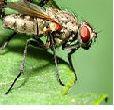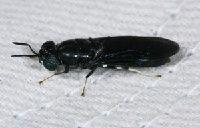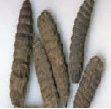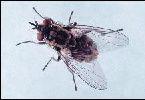Natural Solutions to Things That Bug You (57 page)
Read Natural Solutions to Things That Bug You Online
Authors: Myles Bader

General Information:
 The onion fly can be a real problem if you are growing onions. The fly lays its eggs in an onion and the resulting maggot does a good job of ruining the onion. If you scatter wood ash around the base of the plant it will help keep their number down since the flies will shy away from wood ash.
The onion fly can be a real problem if you are growing onions. The fly lays its eggs in an onion and the resulting maggot does a good job of ruining the onion. If you scatter wood ash around the base of the plant it will help keep their number down since the flies will shy away from wood ash.
ROOT MAGGOT FLY
General Information:
 This fly looks like the common housefly but likes vegetables. There are a number of species all preferring their own veggie. The adult female lays her eggs on the roots of the vegetables and when the maggots hatch they proceed to live off the roots thus weakening the plant.
This fly looks like the common housefly but likes vegetables. There are a number of species all preferring their own veggie. The adult female lays her eggs on the roots of the vegetables and when the maggots hatch they proceed to live off the roots thus weakening the plant.
WOOD ASHES TO THE RESCUE
If you sprinkle a goodly amount of wood ashes around the roots it will keep these flies at bay and save your vegetables. Fireplace ashes will also do a very efficient job of keeping them away.

TAR PAPER WORKS
Place circles of tarpaper around the plants making a slit in each so that it will fit fairly snug around the plant.
DIG UP THE SOIL
One of the best methods of getting rid of root maggot flies is to dig up the soil in the fall and leave the pupae of the root maggots exposed to the cold of winter. This will also provide feed for hungry birds.
SAW FLIES
CALL IN THE WASP
One of the best methods of controlling sawflies is to use parasitic wasps.
ASHES AWAY
Dusting with wood ashes will usually get rid of sawflies.
SOLDIER FLY
 This is one of the more unusual insects found around the home. It is the larva of the stratiomyid, or soldier, fly. The larval form of the soldier fly is a segmented, maggot-like creature that can be quite scary to someone not familiar with what it really is. However, both the larva and the adult are harmless.
This is one of the more unusual insects found around the home. It is the larva of the stratiomyid, or soldier, fly. The larval form of the soldier fly is a segmented, maggot-like creature that can be quite scary to someone not familiar with what it really is. However, both the larva and the adult are harmless.
The most common species of soldier fly is considered a filth fly because of its habit of breeding in manure and garbage.
The feeding habits of the larva, however, are not easy to classify since the larval stage of the soldier fly feeds on decaying organic material including manure and very moist, rotting vegetable matter. Since they like manure piles these insects are sometimes considered beneficial because they prey on other insects, like house flies.
They also like compost piles and are being sold by at least one manufacturer for use in specially designed containers to quickly decompose kitchen waste.
Soldier flies will on occasion infest animal carcasses. Problems in homes sometimes occur after a bee’s nest has been exterminated in a wall since soldier fly larvae are one of several insects that may scavenge waste materials in bee combs.
Soldier flies are usually seen during their pre-pupal stage. Pre-pupal larvae are full grown larvae that have stopped feeding and begin a time of exploring before pupating (changing into an adult, or in this case the fly, form). During this exploring phase, larvae may travel several yards from the breeding site and may be seen crawling along a floor, patio, or fireplace hearth.
Soldier fly larvae are about one inch-long, have no legs, dark brown in color and flattened. The outer covering “skin” has a distinctive, leathery texture. Soldier fly larvae are also remarkably tough and are able to survive for weeks in a jar with no food or water.

The adult stage of the most identifiable species of soldier fly is about ¾ inch-long and black, with a translucent segment on the tail, or abdomen. Adult flies are rather lazy until induced to fly as well as being attracted to light, but do not seem attracted to food.
These flies are harmless to people and are beneficial in helping decompose garbage and filth. In some area they also help control more noxious insect pests, like house flies. They will frequent poorly maintained compost piles; wet grains or other decaying vegetable material, which may provide breeding sites for soldier flies. If you have a dead bird or rodent in an attic or chimney it may also be the reason for soldier fly or blow fly infestations.
STABLE FLY
 Stable flies are not always found in filthy situations and both sexes feed on the blood of animals, including humans, usually biting around the ankles.
Stable flies are not always found in filthy situations and both sexes feed on the blood of animals, including humans, usually biting around the ankles.
The bites are painful; however, they are not known to transmit disease to humans. Females will lay eggs in rotting straw and manure, moist piles of animal feed and yard waste.
The stable fly or dog fly is a blood-sucking fly which is of considerable importance to people, pets, livestock, and the tourist industry in Florida. Stable flies usually attack animals for their blood meal, but in the absence of an animal host will also bite man.
In its normal environment the stable fly is not considered a pest to man. However, certain regions of the United States have considerable problems with large numbers of stable flies attacking man. Areas hard hit are the coastal part of New Jersey, areas of Lake Superior and Michigan and the Tennessee valley. West Florida and along the Gulf coast to Louisiana are areas that historically have stable fly problems.
Stable flies like to breed in soggy hay, grasses or feed, piles of moist fermenting weed or grass cuttings, peanut litter, seaweed deposits along beaches and in soiled straw bedding. The female, when depositing eggs will often crawl into loose material.
Each female fly may lay 500-600 eggs in 4 separate batches. The eggs are tiny, white and sausage-shaped and will hatch in 2-5 days into larvae which feed and mature in 14-26 days.
Larvae are typical maggots and transform to small reddish-brown capsules (pupae) from which the adult flies will emerge. The average life cycle is 28 days ranging from 22-58 days depending on the weather! Adult stable flies can fly up to 70 miles from their breeding sites and as an adult is similar to the house fly in size and color. However, the stable fly has a long bayonet-like mouthpart for sucking blood. Unlike many other species of flies, both male and female stable flies feed on blood.
Stable flies will attack people, dogs, cats, and agricultural animals throughout Florida. Their bite is extremely painful to both man and animal. When hungry, stable flies are quite persistent and will continue to pursue a blood meal even after being swatted at. Although the bite is painful, there is little irritation after the bite, and few people exhibit an allergic reaction to it.
While one stable fly does not cause significant damage, 50-100 of these blood-sucking pests together with 500 horn flies cause a daily loss of blood. This can result in a loss of 10-20 percent in milk production and up to 40 pounds of beef gain eliminated per animal each year.
Stable flies also are known to transmit such diseases as anthrax, Equine Infectious Anemia and anaplasmosis to animals. In addition, bite wounds can be sites for secondary infection. Stable flies will feed mainly on the legs of cattle and horses and leave an animal immediately after feeding, which means that they may go unnoticed unless heavy outbreaks occur. They are inactive at night, roosting on fences, buildings, trees, and bushes.
The most practical and economical method for reducing stable fly populations is the elimination or proper management of breeding sources. It is important to remember that flies cannot develop in dry materials.
Stable flies breed in the following types of material:
Green Chop or Silage
- The stable fly maggot thrives in decaying plant material, such as old silage in and around feed troughs and trench silos. Silage probably has a greater potential for producing stable flies than almost any other material found on today's farms.
More than 3,000 stable fly maggots per cubic foot of silage have been found in mid-January on some West Florida farms, and 5 times that in number in late summer.